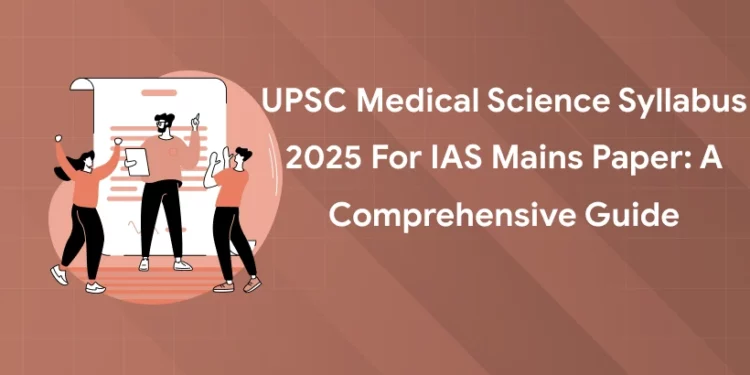Table of Contents
Preparing with Medical Science as your optional subject for UPSC Civil Services Examination (CSE) requires a thorough understanding of the syllabus. The UPSC 2025 Medical Science Syllabus is definitely a combination of some foundational and advanced topics, taking into account the aspirants being of the medicine stream. This is a detailed break-up and guide for the syllabus with adequate tips for effective preparation.
UPSC Medical Science Syllabus 2025 Overview
Medical Science is an excellent optional for UPSC Mains aspirants with a solid academic background in medicine. It will work for those who have graduated with a degree in Medical Science or are professionals such as doctors, nurses, biomedical engineers, and pharmacists. The optional Medical Science consists of two papers, Paper I and Paper II, which carry 250 marks each, aggregating to a sum total of 500 marks.
Medical Science Syllabus for UPSC PDF
1: Which one of the following is not a Harappan site?
UPSC Medical Science Syllabus 2025 for IAS Mains Paper – I
| Subject | Topics |
|---|---|
| Human Anatomy | – Applied anatomy of upper and lower limbs, joints, shoulder, hip, and knee. |
| – Blood supply and lymphatic drainage of tongue, thyroid, mammary gland, stomach, liver, prostate, gonads, uterus. | |
| – Clinical anatomy of kidney, urinary bladder, uterine tubes, vas deferens. | |
| – Embryology: Placenta, placental barrier, development of heart, gut, kidney, uterus, ovary, testis, and congenital abnormalities. | |
| – Nervous system: Anatomy of brain ventricles, cerebrospinal fluid circulation, sensory pathways, cranial nerves, autonomic nervous system. | |
| Human Physiology | – Impulse conduction, muscle contraction, reflexes, posture, equilibrium, sleep, consciousness. |
| – Endocrine system: Hormone actions, secretion, pancreas, pituitary gland. | |
| – Reproductive system: Menstrual cycle, lactation, pregnancy. | |
| – Blood: Development and regulation of blood cells. | |
| – Cardiovascular functions, cardiac output, blood pressure regulation. | |
| Biochemistry | – Organ function tests: liver, kidney, thyroid. |
| – Protein synthesis, vitamins, and minerals. | |
| – Restriction Fragment Length Polymorphism (RFLP), Polymerase Chain Reaction (PCR), Radio-immunoassays (RIA). | |
| Pathology | – Inflammation, repair, cancer growth disturbances. |
| – Pathogenesis and histopathology of diseases: rheumatic/ischemic heart disease, diabetes, cancers (breast, oral, cervix), leukemia. | |
| – Cirrhosis, glomerulonephritis, tuberculosis, acute osteomyelitis. | |
| Microbiology | – Humoral and cell-mediated immunity. |
| – Laboratory diagnosis of diseases: meningococcus, salmonella, shigella, herpes, dengue, polio, HIV/AIDS, malaria, amoebiasis, giardiasis, fungal infections. | |
| Pharmacology | – Mechanisms and side effects of drugs: antipyretics, antibiotics, antimalarials, antidiabetics, antihypertensives, diuretics, vasodilators, antivirals, antifungals, anticancer drugs, immunosuppressants. |
| Forensic Medicine and Toxicology | – Forensic examination of injuries, wounds, blood, and seminal stains. |
| – Poisoning, sedative overdose, hanging, drowning, burns. | |
| – DNA and fingerprint analysis. |
Crack UPSC with Expert Mentors! Get Free Demo Classes!
UPSC Medical Science Syllabus 2025 – Paper II
| Subject | Topics |
|---|---|
| General Medicine | – Etiology, clinical features, diagnosis, and principles of management (including prevention) of: Tetanus, Rabies, AIDS, Dengue, Kala-azar, Japanese Encephalitis. |
| – Ischaemic heart disease, pulmonary embolism, bronchial asthma, pleural effusion, tuberculosis, malabsorption syndromes, acid peptic diseases, viral hepatitis, cirrhosis of liver. | |
| – Glomerulonephritis, pyelonephritis, renal failure, nephrotic syndrome, renovascular hypertension, complications of diabetes mellitus, coagulation disorders, leukemia. | |
| – Hypo and hyperthyroidism, meningitis, encephalitis. Imaging in medical problems: ultrasound, echocardiogram, CT scan, MRI. | |
| – Anxiety, depressive psychosis, schizophrenia, ECT (Electroconvulsive Therapy). | |
| Pediatrics | – Immunization, baby-friendly hospital, congenital cyanotic heart disease, respiratory distress syndrome, broncho-pneumonias, kernicterus. |
| – IMNCI classification and management, PEM grading and management, ARI and diarrhea in children under five and their management. | |
| Dermatology | – Psoriasis, allergic dermatitis, scabies, eczema, vitiligo, Steven Johnson’s syndrome, lichen planus. |
| General Surgery | – Clinical features, causes, diagnosis, and principles of management of cleft palate, harelip. |
| – Laryngeal tumor, oral and esophageal tumors, peripheral arterial diseases, varicose veins, coarctation of aorta. | |
| – Tumors of thyroid, adrenal glands, breast conditions (abscess, cancer, fibroadenoma, adenosis). | |
| – Bleeding peptic ulcer, tuberculosis of bowel, ulcerative colitis, cancer stomach, renal mass, cancer prostate. | |
| – Haemothorax, stones (gall bladder, kidney, ureter, urinary bladder), management of surgical conditions of rectum, anus, anal canal, gall bladder, bile ducts. | |
| – Splenomegaly, cholecystitis, portal hypertension, liver abscess, peritonitis, carcinoma head of pancreas. | |
| – Fractures (spine, Colles’ fracture), bone tumors. Endoscopy, laparoscopic surgery. | |
| Obstetrics and Gynaecology | – Diagnosis of pregnancy, labour management, complications of 3rd stage, antepartum/postpartum hemorrhage, newborn resuscitation. |
| – Management of abnormal lie, difficult labor, small for date/premature newborn. | |
| – Diagnosis and management of anemia, preeclampsia, toxemias of pregnancy, post-menopausal syndrome. | |
| – Family planning: intrauterine devices, pills, tubectomy, vasectomy. Medical termination of pregnancy (legal aspects). | |
| – Conditions like cancer cervix, leucorrhoea, pelvic pain, infertility, dysfunctional uterine bleeding (DUB), amenorrhea, fibroid, prolapse of uterus. | |
| Community Medicine (PSM) | – Principles, methods, approaches, and measurements of epidemiology. |
| – Nutrition, nutritional diseases/disorders, nutrition programs. | |
| – Health information collection, analysis, and presentation. | |
| – Objectives, components, critical analysis of national programs for control/eradication of malaria, kala-azar, filaria, tuberculosis, HIV/AIDS, STDs, dengue. | |
| – Critical appraisal of healthcare delivery systems. | |
| – Health management and administration: techniques, tools, program implementation, evaluation. | |
| – Reproductive and child health, National Rural Health Mission, Millennium Development Goals (objectives, components, goals, status). | |
| – Management of hospital and industrial waste. |
Crack UPSC with Expert Mentors! Get Free Demo Classes!
Why Choose Medical Science as an Optional Subject?
Medical Science is a popular optional subject among doctors appearing for the UPSC Mains. It offers several advantages:
- Familiarity with the Subject: Medical graduates already possess a strong grasp of the concepts, making it easier to cover the syllabus.
- Scoring Potential: The subject is highly factual and less subjective, which helps in scoring well if presented concisely and accurately.
- Overlap with General Studies Papers: Topics like public health, nutrition, and immunization programs overlap with General Studies and essay writing.
Medical Science as an optional subject for the UPSC Mains can be a game-changer if approached systematically. Mastering the syllabus and fine-tuning your answer-writing skills will increase your chances of clearing this competitive examination.
Start your preparation today with a well-structured plan and the right resources. Consistency and dedication are the keys to cracking the UPSC!
Crack UPSC with Expert Mentors! Get Free Demo Classes!
Frequently Asked Questions
Q1: Is Medical Science a scoring optional in UPSC?
Ans: Yes, due to its factual nature and clear-cut syllabus, Medical Science is considered a scoring optional.
Q2: How much time is needed to prepare for Medical Science optional?
Ans: It typically requires 4-5 months of dedicated preparation, depending on your familiarity with the subject.











